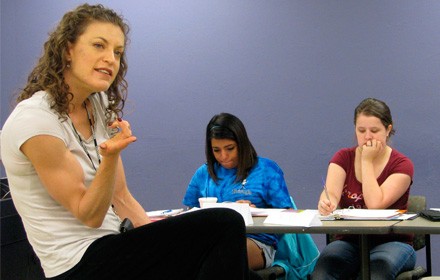Dr. Fohr Teaches Respect with World Religions

In a world where religion plays a key role in geopolitical conflict, studying world religions is a weighty undertaking. Dr. Sherry Fohr, Associate Professor of Religion, says that teaching World Religions is challenging. Good thing it’s also her favorite course to teach. The course introduces students to Hinduism, Buddhism, Jainism, Confucianism, Islam, Judaism, and Christianity.
“Our class discussions were fantastic and ranged over a huge number of tricky issues, but she helped the class always stay respectful of others…”
One student said, “This subject can be tricky to teach, but Dr. Fohr reminded students repeatedly that 1) she isn’t out to change anyone’s religion, and 2) we need to approach other religions and cultures with respect. Our class discussions were fantastic and ranged over a huge number of tricky issues, but she helped the class always stay respectful of others and never let the discussions get too far out of hand.”
Dr. Fohr says that respect is the guiding principle of the course. She says, “The purpose of this course is NOT to change students’ personal beliefs or religious affiliations. I will respect students’ religious beliefs, practices, and affiliations throughout this course. I will also respect students’ choices to be religious or to not be religious. We will not be evaluating whether or not the beliefs of any religion are true. Instead we will endeavor to understand the internal logic of each religion by examining how different religious beliefs (ontology) explain different religious practices (soteriology).”
Dr. Fohr said, “I introduce students to what different people believe and do. I help them understand the world better, including what happens as reported in the news. I am able to correct inaccurate assumptions or beliefs concerning people of other traditions.” But it’s not just students who look at the world differently thanks to class. According to Dr. Fohr, “My students are always very curious about other religions and we have great discussions. They often help me see issues in different ways.”
In 2013, Dr. Fohr blazed a new trail for technology-assisted teaching, using YouTube to facilitate the same kind of thoughtful discussion she stimulates in the classroom.